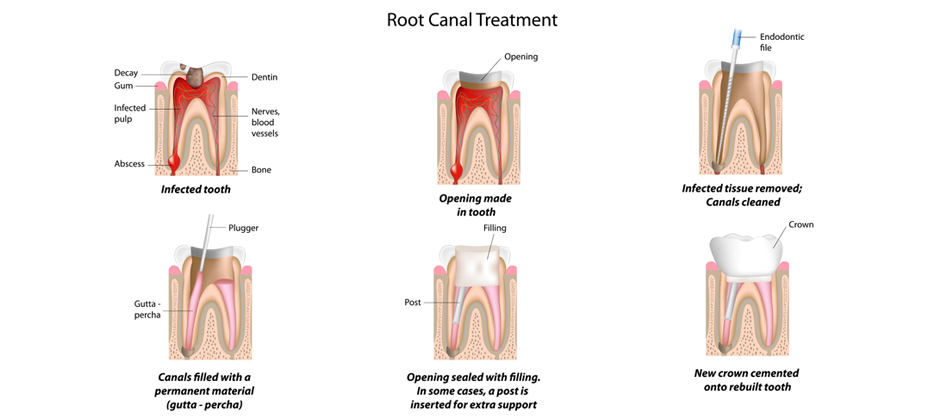Endodontic treatment is more prominently called as root canal, which is performed when the nerve of a tooth gets infected and the patient wishes to keep the tooth. If the root canal is not preformed, dentists would have to remove the teeth with infected nerve systems. Just to save an infected teeth, root canal is conducted to preserve the tooth structure. In addition, as endodontic therapy retains the natural tooth, no artificial tooth is required.
In this piece of post, we would have a sneak peek into the procedure followed to perform this endodontic treatment:
1st Phase – Placement of Rubber Dam
After applying some local anesthesia, your tooth will be “isolated” by placing a rubber dam, which is a thin sheet of latex of 6″ x 6″.
Now the dentist will create a hole in the center of the sheet. The same sheet with the hole will be kept over your tooth and a metal clamp is positioned to fix the dam in place.
Now the tooth can be cleaned and dried up without creating any saliva. This is necessary to make that specific tooth saliva free by performing this procedure as the saliva contains bacteria and some other waste so a rubber dam is placed to work as a barrier keeping the tooth saliva free.
2nd Phase – Forming Access Cavity
To proceed with the surgery, the dentist will create an access to its actual problem area, which is called forming an “access cavity.”
For this a dental drill is used to create a hole leading to the root of your pulp chamber. Through this the dentist will wash out the tooth decay or any fragile tooth pieces present there.
3rd Phase – Ascertaining the Tooth Length
Your dentist will now have to measure your tooth length to work within the given length. This can be done either by radiographic measurements or electronic measurements.
4th Phase – Cleaning and Defining the Tooth’s Root Canals
For cleaning purpose the dentist uses files to clean and shape your tooth. These are tapered straight pins that are moved up and down, following a twisting motion, in tooth’s root canals.
These motions scrape, scrub, and shave the corners of the canals, thus draining out the debris and shaping them.
During this process tooth irrigation is also done occasionally to flush out the debris from your tooth. This washes away the collected contaminants and any other debris.
5th Step – Sealing of Tooth
After the internal parts of the tooth has been completely cleansed and shaped, now it is time to seal the root that has been hollowed after flushing out the contaminants. The dentist would either fill the tooth temporary or fill it permanently immediately. It depends on the specific requirement.
Types of Root Canal Filling Material
Gutta percha is the most frequently used root canal filling substance, relied upon by the majority of Endodontists. It is available in preformed cones having the matching dimensions with the files that are used to define the tooth’s canals.
6th Phase – Placement of Gutta Percha
Now the separate cones of gutta percha are put inside the tooth to seal the hollow parts of the tooth that has been drained out.
Sealer is a constituent of this process which is combined with every gutta percha cone to place it into the canal, or otherwise it can also be applied directly inside the root canal prior to the insertion of the cone. In this process several separate cones can be required to completely fill up the interior parts of the tooth.
For this process of filling, the dentist will make the gutta percha soft by using a hot instrument to it. Now it is ready to be packed down, so that it can closely take the shape of the tooth’s interior parts.
Creating a Temporary Filling
After your dentist has completed the process of sealing of your tooth, they will put a kind of temporary filling. This will pack the cavity access created, when the entire process of treatment has begun, to protect the root canal procedures.
Now, the root canal process has come to an end, but your tooth is still in need of some extra attention. At this point, a permanent restoration is yet to be placed.
You must choose the most suitable dental restoration to consolidate your tooth that has undergone root canal process. It will ensure the long-term establishment of your tooth’s Endodontic treatment.
Synopsis
This is the phase wise procedure that a dentist follows while performing a root canal procedure. If you are expected to undergo this process, rest assure that you actually require a root canal and don’t forget to choose the most professional and experienced dentist to perform this process as it requires good expertise and experience! Rest assured it’s not hurting as most of us believe!




